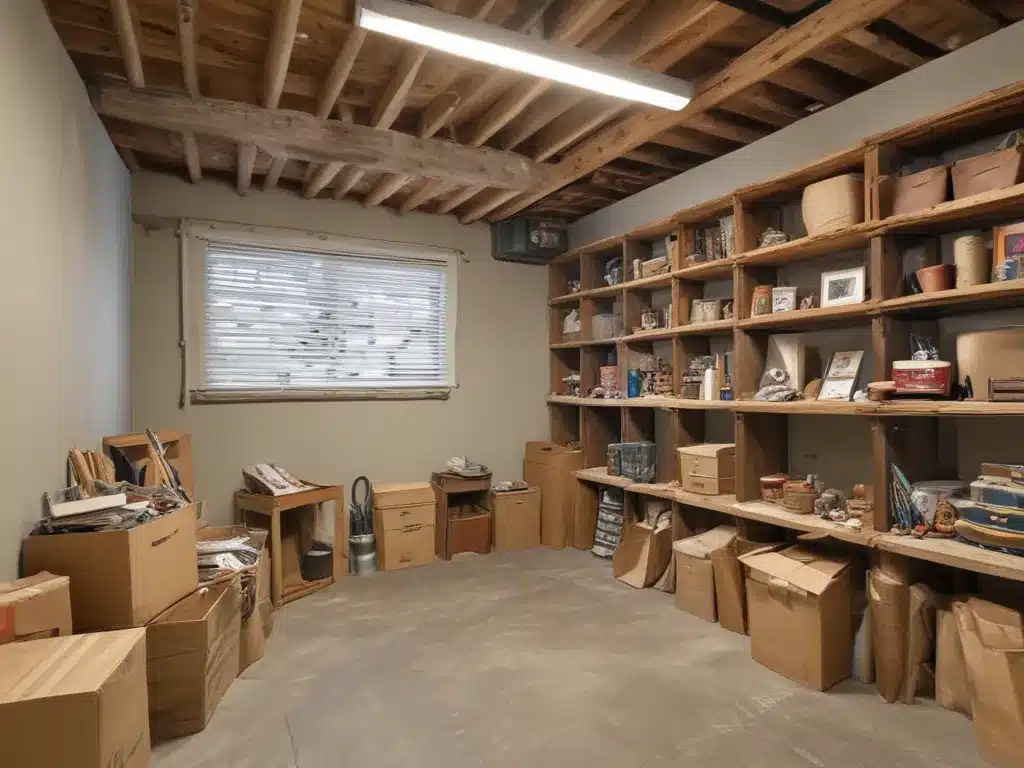Introduction: The Basement Dilemma
As a homeowner, I’ve always struggled with the enigma that is my basement. It seems to be the catch-all for all the items we no longer use, the remnants of our past lives, and the forgotten treasures that have been relegated to the dark corners of our homes. However, the time has come to confront this challenge and reclaim the valuable space that lies beneath our feet. In this comprehensive guide, I will share my insights and strategies on how to declutter your basement, transforming it from a cluttered abyss to a functional and organized haven.
Understanding the Basement Mindset
The basement often becomes a dumping ground for our possessions, and it’s easy to understand why. We convince ourselves that we might need these items “someday,” or we simply don’t want to deal with the hassle of sorting through and parting with our belongings. This mentality, however, can lead to a basement that is overwhelming and seemingly impossible to tackle.
To break free from this mindset, I need to ask myself some crucial questions. What purpose do I want my basement to serve? What items do I truly need to keep, and which ones can I let go of? By shifting my perspective and focusing on the end goal, I can begin to approach the decluttering process with a renewed sense of purpose and determination.
Assessing the Basement
The first step in the decluttering process is to assess the current state of my basement. I will need to take a deep dive and examine every nook and cranny, categorizing the items I find into distinct groups. This may include:
- Seasonal decorations
- Hobby and craft supplies
- Old electronics and appliances
- Sentimental keepsakes
- Unused furniture
- Miscellaneous items
By creating a comprehensive inventory, I can better understand the scope of the task at hand and develop a strategic plan for tackling the clutter.
Decluttering Strategies
With a clear understanding of the basement’s contents, I can now implement a series of decluttering strategies to streamline the process. One effective approach is the “one-year” rule, where I ask myself if I’ve used an item within the past 12 months. If the answer is no, then it’s likely a candidate for donation or disposal.
Another useful tactic is the “three-pile” method, where I sort my belongings into three categories: keep, donate, and discard. This helps me make decisive decisions and avoid the temptation to hold onto items “just in case.”
For sentimental items, I may need to employ a more thoughtful approach. I can take the time to reminisce and capture the memories associated with these keepsakes, then select only the most meaningful ones to keep.
Organizing and Storing
Once I’ve decluttered my basement, the next step is to organize and store the remaining items in a way that maximizes the available space. This may involve investing in storage solutions such as shelving units, plastic bins, or even custom cabinetry.
When it comes to storage, I need to consider factors such as accessibility, moisture control, and efficient use of vertical space. By creating a well-organized system, I can ensure that my basement remains tidy and that I can easily retrieve the items I need when I need them.
Maintaining a Clutter-Free Basement
Decluttering is not a one-time task; it’s an ongoing process that requires vigilance and discipline. To maintain a clutter-free basement, I will need to establish a regular cleaning and organization routine. This may involve setting aside specific times each month or year to review and purge the items in my basement.
Additionally, I can implement strategies to prevent the accumulation of new clutter, such as establishing a “one-in, one-out” policy for bringing new items into the basement or creating a designated storage space for incoming items that need to be sorted and integrated into the existing organization system.
Maximizing the Basement’s Potential
By decluttering and organizing my basement, I can unlock a world of possibilities for this underutilized space. Perhaps I can transform it into a home gym, a cozy home office, or a dedicated crafting studio. Alternatively, I could use the newly available space to store seasonal items or set up a workshop for my hobbies.
The key is to approach the basement with a clear vision and purpose. By identifying the optimal use for this space, I can create a functional and enjoyable environment that enhances the overall livability of my home.
Conclusion: The Joys of a Decluttered Basement
Conquering the basement clutter may seem like a daunting task, but the rewards are well worth the effort. By taking the time to declutter, organize, and maximize the potential of this forgotten space, I can reclaim a sense of control, clarity, and even joy in my home. The process may not be easy, but the sense of accomplishment and the newfound freedom that comes with a decluttered basement will make it all worthwhile.
If you’re feeling overwhelmed by the prospect of tackling your basement, I encourage you to explore the services offered by AdamCleaning.uk. Their team of professional organizers can guide you through the decluttering process, providing expert advice and a helping hand to ensure that your basement transformation is a resounding success.







